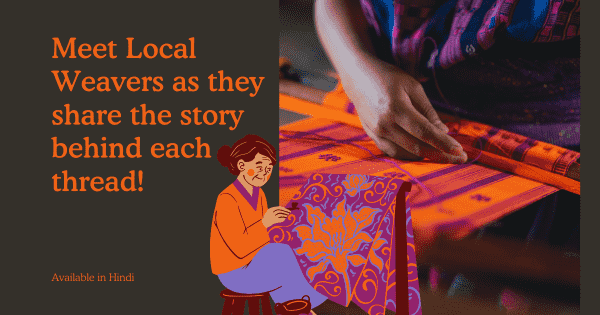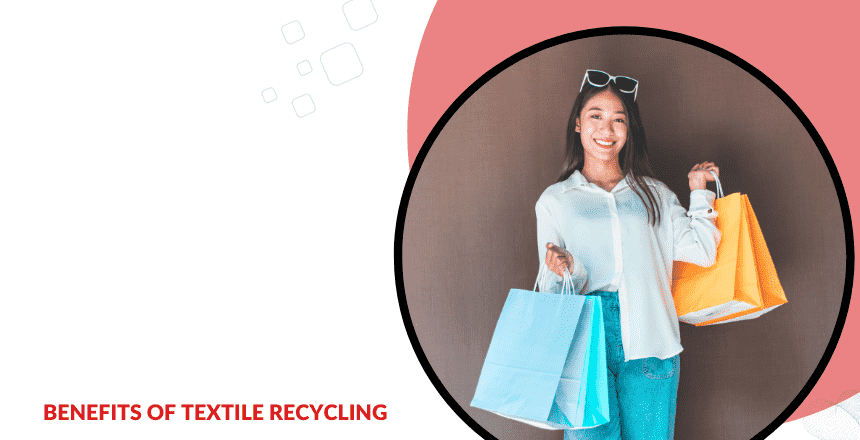Benefits of Textile Recycling, The practice of reusing or reprocessing used clothing, fibrous material, and leftover clothing from the production process is known as the Benefits of textile recycling. Another method to define textile recycling is as follows: इसमें कपड़े के अपशिष्ट रेशों का पुनरुत्पादन और पुन: उपयोग दोनों शामिल हैं। Open recycling is the process of opening the fibers physically or chemically to restore them to their fibrous state. Mechanically, this entails cutting, shredding, and carding; after the used textiles have been opened, they can then be further handled to create new goods for repurposing. किसी उत्पाद को उसकी मूल स्थिति में लौटाने के लिए सबसे आम रणनीतियाँ आवश्यक हैं। एक प्लास्टिक वस्तु को पिघलाकर एक नई वस्तु बनाना द्वितीयक पुनर्चक्रण है। Pyrolysis and hydrolysis, which are used in tertiary recycling, transform plastic waste into fundamental chemicals or fuel. Quaternary recycling is the practice of burning fibrous solid refuse and making use of the heat produced.
In a world where sustainability is paramount, textile recycling stands as a vital contributor to environmental preservation. This practice not only reduces the burden on landfills but also conserves resources, minimizes pollution, and promotes responsible consumption. इसके अलावा, यह रोजगार के अवसर पैदा करता है और स्थानीय अर्थव्यवस्थाओं का समर्थन करता है। कपड़ा रीसाइक्लिंग को अपनाना हरित, अधिक टिकाऊ भविष्य की दिशा में एक आवश्यक कदम है, जहां कपड़े के हर धागे को एक उद्देश्य मिलता है, और हमारे ग्रह को कम अपशिष्ट और पर्यावरणीय प्रभाव से लाभ होता है।
Textile recycling offers numerous environmental and economic benefits. सबसे पहले, यह अपशिष्ट धाराओं से वस्त्रों को हटाकर लैंडफिल पर बोझ को कम करने में मदद करता है, इस प्रकार मूल्यवान लैंडफिल स्थान को संरक्षित करता है। Recycling textiles also saves energy and resources that would otherwise be used in the production of new textiles. इसके अतिरिक्त, यह विनिर्माण प्रक्रिया से जुड़े ग्रीनहाउस गैस उत्सर्जन में कटौती करता है।
इसके अलावा, कपड़ा पुनर्चक्रण टिकाऊ प्रथाओं को बढ़ावा देता है और कच्चे माल की आवश्यकता को कम करता है, अंततः पानी का संरक्षण करता है और प्रदूषण को कम करता है।
It also supports local economies by creating jobs in the recycling and upcycling industries. Moreover, donating or repurposing textiles can benefit those in need. कुल मिलाकर, कपड़ा रीसाइक्लिंग पर्यावरण, अर्थव्यवस्था और समुदायों के लिए एक लाभदायक समाधान है|
Purchase Brand Lingerie at the lowest Price: Click Here
Purchase Premium Quality Innerwear at the lowest Price: Click Here
Purchase Beauty Products at the lowest Price: Click Here

The Need for Textile Recycling
The technique of recovering used garments and other textiles for reuse or material recovery is known as textile recycling. It serves as the industry’s cornerstone for recycling textiles. SMART, the Association of Wiping Materials, Used Clothing, and Fibre Industries, represents this group in the US. वस्त्रों का दान, संग्रह, छंटाई और प्रसंस्करण, इसके बाद अंतिम उपभोक्ताओं के लिए उपयोग किए गए कपड़ों, चिथड़ों या अन्य बरामद सामग्री का परिवहन, कपड़ा रीसाइक्लिंग प्रक्रिया में सभी आवश्यक चरण हैं।
Of course, the textile industry itself serves as the foundation for the expanding textile recycling sector. दुनिया भर में कपड़ा बाजार अब $ 1 ट्रिलियन के करीब है और इसमें परिधान, बिस्तर, पर्दे, लिनेन, फर्नीचर और मनोरंजक उपकरण सहित उत्पादों की एक विस्तृत श्रृंखला शामिल है।
Recyclable textiles are becoming more and more important. Worldwide, an estimated 100 billion garments are created each year. Around 17 million tonnes of textile municipal solid waste (MSW), or 5.8% of all MSW generated, were produced in 2018, according to the U.S. EPA. उसी वर्ष, कपड़ों और जूतों से बने वस्त्रों की वसूली 13.0% थी, जबकि चादरों और तकियों से बने वस्त्रों की वसूली 15.8% थी। As a result, as we work to get closer to a society with no landfills, textile recycling is a big issue that needs to be addressed.
Natural fibers might take several weeks to several years to disintegrate in landfills. Methane and CO2 gas could be released into the atmosphere by them. सिंथेटिक कपड़ा भी टूटने से बचाने के लिए बनाया जाता है. They might discharge dangerous materials into the landfill, contaminating the soil and groundwater nearby.
Recycling textiles has the following positive effects on the environment:
- Reduces the need for landfill space while keeping in mind that natural fibers have the potential to generate greenhouse gasses and that synthetic fiber products do not disintegrate.
- Used less virgin fibers
- Decreased water and energy usage
- Pollution prevention
- Decreased need for dyes.
Sources for recycled textiles
There are two main sources of textiles that are produced for recycling. Among these sources are:
- Post-consumer, जिसमें कपड़े, कार की असबाब, घरेलू सामान और अन्य सामान शामिल हैं।
- Pre-consumer, कौन से सूत और कपड़ों के उत्पादन के उप-उत्पाद के रूप में उत्पादित प्रदूषण के साथ-साथ अन्य लिपियों से इंडस्ट्रियल आफ्टर के गारमेंट सर्वेक्षण शामिल हैं।
Numerous business programs, including those of Nike and Patagonia, as well as non-profit organizations encourage the donation of used clothing.
Reusable and Fashionable Textiles

About 50% of the textiles collected in the European Union are recycled, while another 50% are utilized again. A third of donated clothing is made into industrial rags or about 35%. पुराने परिधानों का अधिकांश हिस्सा विदेशों में निर्यात किया जाता है। ऑक्सम नामक एक ब्रिटिश गैर-लाभकारी संगठन का मानना है कि उसके 70% कपड़े दान अफ्रीका में जाते हैं। Given that such programs may have a negative effect on the local textile industry, traditional apparel, and waste generation, there is some debate concerning the advantages of sending old clothing to Africa.
The method of recycling
It is expected that the textile recycling sector will expand as society becomes more aware of the risks connected with disposing of old textiles in landfills and as new recycling methods emerge. धीमे फैशन जैसे फैशन के रुझान के लिए देखें जो कपड़े और स्थायित्व के बीच संबंध को उजागर करना जारी रखेगा। फास्ट फैशन व्यवसाय का जलवायु परिवर्तन पर बड़ा नकारात्मक प्रभाव पड़ता है और बहुत अधिक प्रदूषण पैदा करता है। Customers may make a difference by supporting clothing manufacturers who are committed to minimizing their influence on climate change and have longer product lifespans.
Important Considerations for Recycling Textiles

The recycling of waste from textile operations and products makes sense for many good reasons. In the end, the resources in this world are limited. Cotton and polyester, which account for more than 85% of the world’s fiber production, are the two main fibers in the textile business. Cotton production competes with food production and is dependent on a limited amount of territory. Polyester extraction harms the ecosystem and depends on limited petroleum-based oil resources. बढ़ती आबादी और अस्थिर जलवायु के साथ, कपड़ा संसाधनों की वैश्विक कमी के साथ-साथ कपड़ा फाइबर के उत्पादन से पर्यावरण के लिए जोखिम भी है, जो 2014 में लगभग 65 मिलियन टन पॉलिएस्टर फिलामेंट्स और कपास फाइबर होने का अनुमान लगाया गया था। As a result, efficient resource management in the sector is now given top importance. The industry is also linked to environmental problems, such as high energy and water consumption and the use of toxic chemicals. Products made of synthetic fibers won’t break down in dumps. Such garbage is disposed of in landfills and takes hundreds of years to decompose. It also pollutes the environment, accumulates, and spreads infectious diseases and odors if not degraded. Woolen clothing does break down, but it also releases methane gas, which is a factor in global warming.
There are many compelling arguments for recycling waste from textile operations and products. इनमें लैंडफिल की आवश्यकता को कम करना, संसाधनों को संरक्षित करना, संबंधित टिपिंग शुल्क का भुगतान करना और उत्पाद निर्माण के लिए सस्ते कच्चे माल तक पहुंच प्रदान करना शामिल है। Even then, the rate of recycling textiles is not very great. Furthermore, economics is frequently cited as the reason for the acceptance of alternative waste disposal methods due to the generally accepted argument that the public lacks the will to engage in recycling.
Additionally, the world’s most polluting business is the textile and apparel sector. Throughout their lifespan, textiles have a significant negative effect on the environment. कपड़ा बनाने के लिए बहुत अधिक पानी, बिजली और रसायनों की आवश्यकता होती है। Recycling textiles will be important for lowering emissions. Increased textile recycling is being pursued in an attempt to lower greenhouse gas emissions.
Recycle what?
Clothing includes a shirt, trousers, jacket, suit, hat, belt, tie, scarf, socks, and more. boots, loafers, and shoes. घरों में वस्त्रों का उपयोग किया जाता है, जिनमें पर्दे, पर्दे, लिनेन, कंबल, रजाई, तौलिये और मैट शामिल हैं।
How Can We Find Waste Textiles?

❖ Most textiles are produced by domestic sources. apparel is thought to have an average lifespan of about 3 years before being discarded as old apparel. कभी-कभी हल्के फीके कपड़ों को भी इसलिए फेंक दिया जाता है क्योंकि वह अपना आकर्षण खो चुका होता है।
❖ Textile trash can also result from the production of yarn and fabric, कपड़ों का निर्माण, और खुदरा क्षेत्र।
❖ Polyester fiber can also be recycled using PET bottles.
❖ Most old consumer textile is now collected by charities, which sort the materials and उन्हें उपयुक्त उद्योगों में व्यवसायों के लिए पेश करें।
The Advantages and Benefits of Textile Recycling
Textile recycling has many benefits and advantages, including:
Environmental benefits: Textile recycling helps to reduce the amount of textile waste that ends up in landfills. By recycling textiles, we can reduce greenhouse gas emissions, conserve natural resources, and नए वस्त्रों के उत्पादन के लिए आवश्यक ऊर्जा की मात्रा कम करें।
Economic benefits: Textile recycling can create jobs and stimulate local economies. यह किफायती कपड़ों और अन्य वस्त्र उत्पादों का स्रोत भी प्रदान कर सकता है।
Social benefits: Textile recycling can benefit communities by providing a way to reuse textiles and reduce waste. यह धर्मार्थ संगठनों का समर्थन करने में भी मदद कर सकता है जो जरूरतमंद लोगों को कपड़े और अन्य वस्त्र प्रदान करते हैं।
Conservation of resources: Textile recycling helps to conserve resources such as water, energy, and natural fibers. By reusing textiles, हम नई सामग्री की आवश्यकता को कम कर सकते हैं and conserve resources for future generations.
Reduction of waste: Textile recycling can help to reduce the amount of waste that ends up in landfills. यह अपशिष्ट निपटान के पर्यावरणीय प्रभाव को कम करने में मदद कर सकता है and conserve landfill space.
Overall, textile recycling is a sustainable and environmentally friendly way to deal with textile waste. वस्त्रों का पुनर्चक्रण करके, हम संसाधनों का संरक्षण कर सकते हैं, कचरे को कम कर सकते हैं और समुदायों के लिए आर्थिक और सामाजिक लाभ पैदा कर सकते हैं।
Pre- or post-consumer waste can be categorized as textile recycling material, which is removed from the waste stream and recycled back into the market. (both industrial and end-consumer). ऑटोमोटिव, एयरोस्पेस, घर के निर्माण, फर्नीचर, गद्दे, मोटे धागे, घर के सामान, कागज, परिधान और अन्य उद्योगों में उपयोग के लिए कपड़ा, फाइबर और कपास क्षेत्रों के उप-उत्पादों को पूर्व-उपभोक्ता अपशिष्ट बनाते हैं। Any type of garment or home item made from manufactured textiles that the owner no longer requires and chooses to discard is referred to as post-consumer waste. These items are either outgrown, damaged, worn out, or out of style when they are abandoned. These are occasionally donated to charities or given to friends and family, but they eventually wind up in the trash and in municipal landfills.
Tips for the Indian Textile and Apparel Industry’s Growth

Producing high-quality clothing is essential for boosting exports. कपड़ों की शैली, डिज़ाइन और अपील, साथ ही साथ वह कपड़ा जिससे इसे बनाया जाता है और अंततः पहना जाता है, सभी इसकी गुणवत्ता को प्रभावित करते हैं। The fabric serves as the primary raw material in the production of clothing, so the fabric’s GSM (grams per square meter), construction, warp, and weft count, crimp, cover, and drape should all be carefully considered by the garment manufacturer.
Prevention is preferable to treatment
Chemical auxiliary substances are used when processing fiber into yarn and yarn into the fabric to add different dyes. किसी को हमेशा ध्यान रखना चाहिए कि उपचार के लिए रोकथाम हमेशा बेहतर होती है, चाहे वह कारखाने के फर्श पर हो, डाईहाउस में हो या प्रयोगशाला में भी हो।
Take action as soon as you sense certain issues to be present. For this one, you need to move quickly. To prevent any mistakes during and after dyeing and printing, the textiles chosen, the number of dyes used, the chemicals used, etc. should all be very precise. इसके अतिरिक्त, किसी को यह सुनिश्चित करना चाहिए कि संसाधित किए जा रहे कपड़े का प्रसंस्करण से पहले सावधानीपूर्वक निरीक्षण किया जाए। This means that the fabric should be made properly at the spinning and weaving phases to prevent mistakes from occurring later on during the production and processing of clothing.
Many foreign buyers, particularly those from Europe, have set quality standards for the goods they are buying from India. आयातकों के अंत में सख्त गुणवत्ता और निरीक्षण मानकों को व्यवहार में लाया जाता है. The newest methods, tools, and chemicals must be used by processors to deliver finished goods to customers.
Environmental requirements have been added for the shipping of fabrics and clothing to Germany and Europe. इसके अलावा, पीसीपी (पैरा क्लोरो फिनोल), प्रतिबंधित अमाइन, भारी धातु, फॉर्मल्डेहाइड, निकल, एलर्जिनिक डाई इत्यादि जैसे रसायनों के उपयोग पर प्रतिबंध प्रसंस्करण और परिष्करण में उपयोग किए जाने वाले रसायनों के हानिकारक प्रभावों के ज्ञान के परिणामस्वरूप लगाए गए थे। This has caused the processing of textiles and accessories to undergo a completely new set of control points and checks.
Testing and Quality Control

Although more and more divisions in the Indian textile industry are beginning to understand the value of quality control, there is still somewhere, regrettably, there is not as much analytical quality control as one might wish to have. The thumb guideline helps you accomplish more.
Customers are unduly influenced by one instance of poor quality to the point where they advise at least ten other potential customers to steer clear of them. जब गुणवत्ता के दावे में नींव का अभाव होता है, तो गुणवत्ता की छाप प्राप्त करना आम तौर पर असंभव होता है। To consistently produce high-quality products and services, an organization needs to have a supportive culture, a quality improvement method, and a knowledge of what quality means to different customer segments.
It has been observed that 90% of textile defects are the result of insufficient fabric preparation during processing, i.e., before dyeing, and are discovered after the dyeing cycle or printing process is complete. अच्छी गुणवत्ता वाले कपड़े के निर्माण के लिए प्रभावी और चल रही ऑनलाइन प्रक्रिया की निगरानी की आवश्यकता होती है।
Guidance in Institutions
The number of orders from abroad will rise if some schools start offering training to the workforce, exporters realize the need, and compel the workforce to enroll in training. केवल अधिकारियों और पर्यवेक्षकों के बजाय मुख्य कार्यबल को भी प्रशिक्षण प्राप्त करना चाहिए। Every degree of management, from the lowest to the highest, should receive on-the-job training. Only then can the organization advance.
Awareness of the current resources
The textile business lacks knowledge of the newest technologies. Only a small number of major participants use cutting-edge technology, and most still employ traditional techniques. विनिर्माण के परिणामस्वरूप कम कपड़े और कपड़े निर्यात किए जाते हैं जो अंतरराष्ट्रीय मानकों से कम हो जाते हैं। Newer technologies must be implemented if products are to be consistent. New technologies are not only cost-effective but also contribute to environmental kindness. Awareness of current resources is vital in promoting sustainability and responsible resource management. प्राकृतिक और मानव निर्मित संसाधनों की उपलब्धता और सीमाओं को समझने से हमें सूचित निर्णय लेने, अपशिष्ट को कम करने और अधिक टिकाऊ भविष्य की योजना बनाने में मदद मिलती है। यह आने वाली पीढ़ियों के लिए एक संतुलित और समृद्ध वातावरण सुनिश्चित करने की दिशा में एक महत्वपूर्ण कदम है।
The sector must focus on economies of scale, which directly impacts the realization of price and value. कपड़े के गीले प्रसंस्करण के लिए, पर्याप्त बुनियादी ढाँचा और उपयोगिताएँ (जैसे बिजली और पानी) सुलभ होनी चाहिए। Indian industries are still worried about the lack of good water and the price of electricity. There will be good exposure of these technologies at the operating level with the introduction of new technologies into the processing sector in India (such as Ecocontrol, moist cross-linking-based resin finishes, and so on. ), which has a lot of room for development in the textile and apparel industry.
Encouraging individuals to wear more apparel
Since we work in the textile business, we must observe that people spend more on clothing. So that others will follow us, we must generously spend on clothing and display leadership. Putting oneself together properly with nice clothes also improves the wearer’s look. कार्यस्थल, व्यावसायिक आयोजनों, त्योहारों, शादियों और अन्य सांस्कृतिक अवसरों पर लोगों की पोशाक उनके व्यक्तित्व और समग्र कार्य दृष्टिकोण को दर्शाती है। Putting oneself in the correct perspective takes a lot of planning and creativity. There should be a lot of experimentation with colors, fashion, accessories, and design, but there should also be wearing ease, a sense of pleasure, and softness when a person wears a dress.
Conclusion

Thus, it is clear that strict adherence to established norms is necessary for the development of the Indian textile and apparel industries as well as for maintaining one’s place in the highly competitive global market. सफलता का रहस्य समय पर उच्च गुणवत्ता वाले सामान का उत्पादन करना और सम्मानजनक निर्यात आय अर्जित करना है। Additionally, effective online monitoring of manufacturing processes is crucial for achieving high-quality product output. And keeping promises is essential if you want to deliver on time. A company can modernize with the newest technology machines once it has coThe Need for Textile Recycling Control over its operations and profitability. Textile recycling offers numerous benefits for both the environment and individuals. By diverting textiles from landfills, it reduces waste and conserves resources. Recycling textiles also minimizes water and energy consumption, decreases pollution, and lowers greenhouse gas emissions. Additionally, it supports sustainable fashion and creates opportunities for job growth in the recycling industry.
Textile recycling offers environmental benefits by reducing waste and conserving resources.यह अभ्यास स्थिरता लक्ष्यों के साथ संरेखित होता है, जिम्मेदार उपभोक्ता व्यवहार को बढ़ावा देता है और परिपत्र अर्थव्यवस्थाओं का समर्थन करता है।

